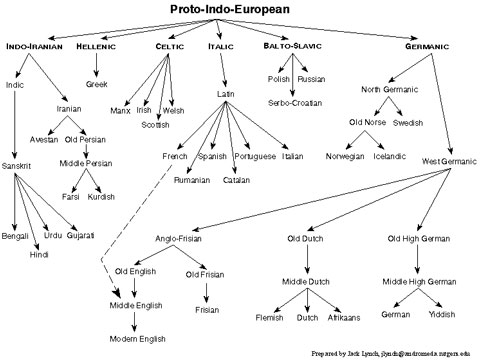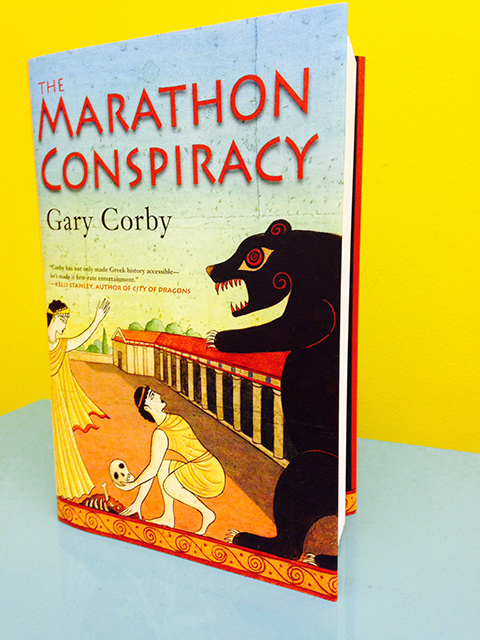
Children tend to look like their parents, and the same is true of languages.
Everyone knows, for example, that French, Italian and Spanish look a lot like Latin.
What is less well appreciated is that you can follow this logic back in time, for a long, long way. Linguists have known for more than 200 years that there’s a lot of similarity between Latin, Greek, German, and surprisingly … Sanskrit. Languages geographically in-between, such as Farsi, are also related. You can see it not only in similarity of words, but also grammar.
Words that are essentially the same between languages are called cognate. The Deus of a Latin prayer is cognate with the Zeus of Greek. Father in English, Vater in German, pater in Latin, patēr in Greek, pitar in Sanskrit are all the same word. They’re cognate.
Together they form a mega-family of languages that stretch from India to Europe, and therefore are known as the Indo-European family.
You can build an ancestral family tree for Indo-European by looking at how much each language has in common with the others, and making the reasonable assumption that anything two languages have in common must originate from their common ancestor. Inevitably this must take you back to a single original ancestor, which is called Proto-Indo-European, or PIE for short.
Here’s a family tree, which I’ve linked to from the work of Jack Lynch at Rutgers:

This diagram is the best I’ve yet scene, because it cuts out the hundred or so extra, highly obscure, and utterly dead languages in the family. You probably don’t care about Early Proto-Tocharian.
People have reconstructed PIE by taking that which is common across the entirely family, and tracing the evolution of sounds and grammar backwards to take an educated guess at the original language.
PIE is thought to have originated somewhere in southern Russia or the Caucasus, probably in about 4,000BC, give or take a millennium. The most popular theory is that the original speakers were a culture called the Kurgans. Whoever the original speakers were, they migrated in waves across Europe and down through Asia.
It interests me that almost everywhere it went, PIE and its children dominated. The natural assumption is conquest did the job—consider for example how Spanish and Portuguese came to be the standards in South America—but even in places where the arrival was peaceful, people mostly adopted the PIE structure. The biggest failure probably is that language Tocharian I mentioned before. It was an intrusion into China, but withered in the face of Chinese, the world’s oldest known extant language.
There seems to be something about PIE that sits well with the human brain. It appears to be a very good language for thinking about mathematics and physics. If you exclude all the progress made by PIE speakers, which means everything achieved by Greek, Germanic, English, Sanskrit, Hindi, Latin, French, Spanish and Italian speakers, then there’s not a lot left. That might perhaps be an issue of cultural domination rather than linguistic advantage, but even so it’s remarkable.
PIE was highly inflected, and that might be part of its strength. You can say an awful lot in a few words. Linguists originally thought PIE must have been somewhat like Sanskrit, because grammatically it’s one of the simpler members of the family, but they now know it’s the other way round. Sanskrit is one of the most advanced members because it’s simpler. PIE was grammatically complex.
The earliest recorded PIE language is in fact the proto-Greek of Linear B, decoded by Michael Ventris.
We can tell a lot about their life from the language. For example, PIE has a word for horse. But there’s no word for wheel. (How do we know that? Because every PIE language has a cognate for the Latin equus, but the word for wheel is different everywhere.)
Several people have had a go at writing something in PIE. The script must obviously be modern since this is long before writing was invented, but it’s fascinating to look at anyway. The most famous thing written in PIE is Schleicher’s Fable. It’s been updated several times since he wrote it in 1868(!), and every time someone updates they go out of their way to make the script more confusing with more silly accents, so here’s the original, in PIE and then in English:
Avis akvāsas ka
Avis, jasmin varnā na ā ast, dadarka akvams, tam, vāgham garum vaghantam, tam, bhāram magham, tam, manum āku bharantam. Avis akvabhjams ā vavakat: kard aghnutai mai vidanti manum akvams agantam. Akvāsas ā vavakant: krudhi avai, kard aghnutai vividvant-svas: manus patis varnām avisāms karnauti svabhjam gharmam vastram avibhjams ka varnā na asti. Tat kukruvants avis agram ā bhugat.
The Sheep and the Horses
A sheep that had no wool saw horses, one of them pulling a heavy wagon, one carrying a big load, and one carrying a man quickly. The sheep said to the horses: “My heart pains me, seeing a man driving horses”. The horses said: “Listen, sheep, our hearts pain us when we see this: a man, the master, makes the wool of the sheep into a warm garment for himself. And the sheep has no wool”. Having heard this, the sheep fled into the plain.
* * *
—This is the first post in a new series written by Soho Crime author Gary Corby. Corby writes historical mysteries set in the world of classical Greece. He’s written The Pericles Commission, The Ionia Sanction, Sacred Games, and, most recently, The Marathon Conspiracy.
